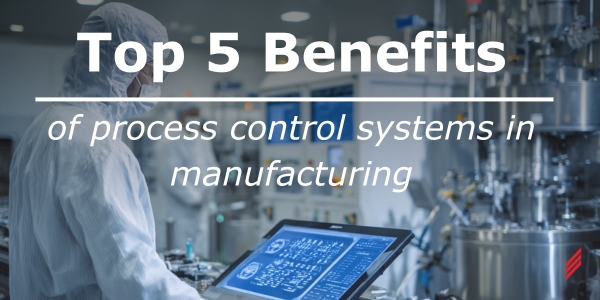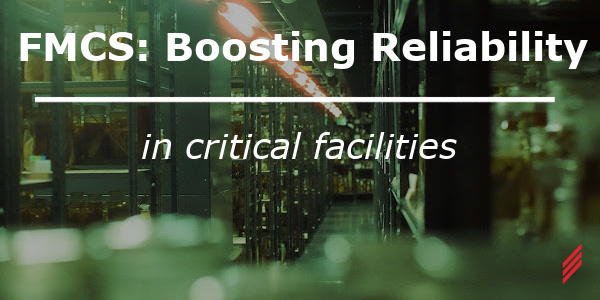Top 5 Benefits of Process Control Systems in Manufacturing
by Hallam-ICS Editorial Team on Nov 18, 2025 2:42:45 PM

Process control systems form the operational backbone of modern manufacturing. When sensors, PLCs, SCADA, HMIs, historians, and MES platforms communicate seamlessly, production becomes safer, faster, and more consistent. In industries such as semiconductors, life sciences, and food & beverage, this integration is critical for both compliance and competitiveness.
The challenge is rarely one device: it’s uniting hundreds of them under a unified control strategy that can adapt to process and regulatory change. That’s where process control system integration services deliver measurable value. From design and programming to commissioning and continuous improvement, a skilled partner helps ensure reliability, uptime, and verified compliance.
Process control services improve manufacturing by automating critical variables, reducing variation, and giving teams real-time visibility for faster decisions. Done well, integration lifts throughput, quality, and safety while creating a scalable foundation for future upgrades.
1. Improved Efficiency and Productivity
Automated control loops keep production variables on target, while interlocks and permissives prevent unsafe or inefficient sequences. Real-time alarms and SCADA dashboards shorten operator response times, and historian data helps identify bottlenecks before they impact output.
For leaders pursuing higher OEE, integrated controls create standardized, trustworthy data. Hallam-ICS details key considerations in choosing how to monitor OEE to ensure that measurements drive actionable improvement.
When upgrading older platforms, staged migrations allow manufacturers to modernize without costly downtime. See how phased control modernization maintained uptime in upgrading control systems when near-zero downtime is required.

2. Enhanced Product Quality and Consistency
Quality and repeatability depend on precise control. Automated sequencing ensures that temperature, flow, pressure, and timing remain within defined limits.
- In semiconductor fabs, this supports ultra-tight process windows and traceability.
- In FDA-regulated environments, consistent automation upholds data integrity and cGMP documentation requirements (21 CFR Part 11).
For multi-site operations, standardizing visualization and alarming across systems improves operator training and oversight. Hallam-ICS explains how to select an industrial SCADA for facility monitoring that supports both performance and compliance.

3. Greater Process Safety and Regulatory Compliance
Process control systems play a central role in maintaining safety and compliance within regulated manufacturing environments. Rather than managing isolated safety programs, integrated control architectures embed compliance into everyday operations—automatically enforcing limits, capturing data, and generating documentation.
Real-Time Process Monitoring and Alarming
Continuous monitoring ensures operators are alerted the moment a process parameter drifts from safe limits. Properly configured alarm management strategies (per ISA-18.2 and IEC 62682) reduce alarm fatigue and prioritize actionable events, allowing teams to respond before minor deviations become safety or quality incidents.
Batch Record Integrity and GMP Compliance
In FDA-regulated industries, process control systems ensure that each step, setpoint, and operator action is electronically recorded and time-stamped. This supports Good Manufacturing Practice (GMP) documentation and the data integrity expectations of 21 CFR Part 11, eliminating manual transcription errors and improving traceability.
Equipment and Recipe Validation
Automated process control simplifies validation and re-qualification when equipment or software changes occur. Consistent code libraries and version control make it easier to demonstrate that validated systems remain compliant after modifications, which is critical for change control and regulatory audits.
SEMI and Industry Standards Alignment
In semiconductor manufacturing, SEMI E95 and SEMI E10 emphasize modifications, which is time, and data integrity across automated systems. Integrated process controls help meet these standards by coordinating tool communication, recipe management, and system diagnostics under one unified framework.
By embedding compliance directly into automation logic, process control systems enable safer, more predictable operations and simplify the documentation manufacturers need to prove regulatory adherence.

4. Data-Driven Decision Making
A unified control architecture captures operational data for continuous improvement. Real-time dashboards display deviations, while historians trend performance for predictive maintenance.
Hallam-ICS demonstrates this in industrial sensor data integration with Ignition and from dusty paper to digital power: unlocking hidden data with Ignition, showing how structured data transforms operations.
Key practices:
- Normalize tag names and units for accurate comparisons.
- Provide role-based dashboards for operators, maintenance, and management.
- Integrate historian and MES data to connect production trends to quality outcomes.

5. Scalability and Flexibility
Scalable control architectures support future expansion. Modular code libraries, open communication protocols, and well-defined I/O structures make it easy to add lines or integrate new equipment without redesign.
Hallam-ICS routinely delivers turnkey process control systems ranging from skid-level automation to multi-million-dollar facility programs. Each includes UL 508A-certified panels, PLC/SCADA programming, OT networking, and cybersecurity aligned with ISA/IEC 62443 principles.
Benefits include:
- Consistent functionality across sites through reusable libraries.
- Quicker qualification and commissioning with standardized templates.
- Easier integration with enterprise analytics and reporting systems.
The Role of a Process Control System Integrator
A qualified process control system integrator designs architectures, implements PLC/SCADA solutions, connects disparate systems, validates performance, and provides ongoing support. The right partner ensures compliance, reduces downtime, and keeps documentation audit-ready.
Hallam-ICS emphasizes collaboration and accountability: design, programming, UL panel fabrication, cybersecurity, and commissioning are all handled under one roof. This integrated approach streamlines communication and reduces vendor overlap.
Practical Comparisons
SCADA vs. stand-alone HMI – A unified SCADA platform centralizes alarming, trending, and user management, improving situational awareness and change control.
Phased upgrade vs. full replacement – A staged migration with temporary bridging and I/O abstraction protects uptime. Hallam-ICS details this approach in near-zero downtime control upgrades.
OEE visibility – Standardizing data collection before analysis yields more reliable metrics. See how to monitor OEE for practical guidance.

FAQ: Process Control, Safety & Compliance
What is process control in manufacturing?
It is the use of instrumentation, automation, and feedback to monitor and adjust variables such as temperature, flow, and pressure in real time, ensuring consistent product quality, efficiency, and safety.
How do process control services reduce risk?
They enforce interlocks and safe operating limits, standardize sequences, and maintain electronic records that support OSHA, SEMI, and GMP audits.
What does a process control system integrator do?
Designs and implements control architectures, programs PLCs and SCADA, validates functionality, and provides commissioning and lifecycle support for reliable, compliant operations.
Build a Safer, Smarter, More Efficient Facility with Hallam-ICS
If you’re exploring ways to strengthen compliance, reliability, and performance, our engineers are ready to help. Let’s discuss how Hallam-ICS can support your next project with dependable process control system integration services tailored to your facility.
About Hallam-ICS
Hallam-ICS is an engineering and automation company that designs MEP systems for facilities and plants, engineers control and automation solutions, and ensures safety and regulatory compliance through arc flash studies, commissioning, and validation. Our offices are located in Massachusetts, Connecticut, New York, Vermont, North Carolina and Texas, and our projects take us world-wide.
You May Also Like
These Related Stories

Inductive Automation's Ignition: Tips, Tricks, and Cheats-How To Use Nested UDT Tags Within Templates

Ignition Tips, Tricks and Cheats-How To Dynamically Build Template Repeater Datasets



No Comments Yet
Let us know what you think